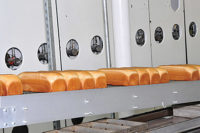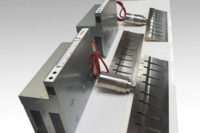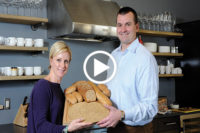The bubble burst
2009 was another watershed year, both economically and globally, with stocks and the real estate market in decline. Signs were strong that the U.S. was in one of the worst economic slumps in decades. The economy was forcing various businesses including restaurants across the country to close, file Chapter 11 or lay off hundreds if not thousands of employees. The world was experiencing a global recession. Private-label and value-baked goods started to become more popular.
In April 2009, Sara Lee opened its new North American research and development center of excellence, The Kitchens of Sara Lee, at the campus of the company’s Downers Grove, Ill. headquarters. The 120,000-sq.-ft. facility houses more than 100 research and development professionals, including chefs, scientists, engineers and packaging designers. This marks the first time the company has had all of its North American food and beverage research and development capabilities under one roof.
In 2010, Sara Lee divested its international household and body care businesses in order to focus on its core categories of food and beverages. In January 2011, the corporation announced its intent to split the company into two pure-play, publicly-traded companies.
As one of the nation’s largest wholesale bakers, Hostess Brands operates about 35 bakeries and some 570 bakery outlet stores and delivers baked goods to supermarkets, mass marketers and convenience stores on 5,500 delivery routes.
The company’s current bread brands include Butternut, Wonder and Beefsteak. It also sells snack cakes and other sweet baked goods under the brands Hostess, Dolly Madison, and Drake’s labels. Responding to growing consumer interest in healthier foods, Hostess is bringing nutritional information to the forefront of its packaging.
This spring, its Smartwhite and Smartwheat 100% Whole Wheat will display easy-to-see nutritional call-outs on packages. However, Hostess Brands filed for Chapter 11 bankruptcy protection in 2012, after emerging from Chapter 11 in 2009.
The future is now
Today, the baking industry is a highly automated, multi-segmented and technology-filled sector, with laser-guided product placement on production lines, lights-out warehousing, robotic case packing, pick-to-light distribution centers, stress-free dough lines, upscale chef customization of products and computerized production line networking. We’re able to use Skype to troubleshoot equipment problems, visit You Tube on the Internet and watch videos of machinery demonstrations and find tradeshow apps on our IPhones. We have access to Internet-linked inventories, find new technology and applied science that is extending product shelf life, ingredients that are creating new types of products and much, much more.
Online searches are replacing family traditions as the main source for food recipes, according to research by The Hartman Group and Public Consultants USA. Nearly half of consumers use social networks to learn about food, and 40% turn to blogs, websites or mobile applications for information and recipes, the research indicates. And, of course, there is The Food Network.
For hundreds of years, the American baker has withstood the tests of time and will continue to do so. In the words of ASB’s An Historical Tribute to Baking, “Through ingenuity, passion and practice, the craft has been integrated with science. As a social experiment and as a reflection on our society, the history of baking has no equal.”
| Baking Museum has even more history |
|
The Bundy Baking Museum of the Baking Arts was created and founded by Russell T. Bundy and is the result of his 40-plus-year passion to collect and preserve baking industry history. The museum hosts vintage and modern signage, vehicles, plaques advertising and turn-of-the-century baking equipment. There’s even an authentic vintage ice cream parlor/lunchroom and a Coca-Cola machine that dispenses 6-oz. bottles for only a nickel. Walking through the museum is like taking a journey through the past, with all of its traditions and artifacts. Bundy Baking Solutions says that its passion and commitment to the baking industry contributes to everything it does, but nowhere else is that more evident than in the Bundy Baking Museum. A most prominent figure in the baking industry, Mr. Bundy began his career with Ekco/Glaco, then a leading manufacturer of baking pans and coating services. His entrepreneurial spirit soon beckoned him to launch his first company, which would eventually become Bundy Baking Solutions, and its six family brands. Mr. Bundy is also president of Russell T. Bundy Associates, Inc., and American Pan Co., both in Urbana, Ohio, the latter known for producing and glazing baking pans and remanufacturing baking equipment. Despite his incredible workload, he has been able through the years to gather all sorts of baking memorabilia and museum-quality items that are artfully displayed, all in one location, as a way to preserve baking’s history and progress. Mr. Bundy acquires some items through donations, others from antique shows across the country, at auctions and through key buyers. Everything from brand names and familiar imagery representative of the many facets of the industry to well-preserved delivery vehicles, machinery, neon advertisement signs and medals span the museum building. “The artifacts are an inheritance connecting us to the past,” writes the company. “The carefully preserved pushcart and brightly painted buggy’s descendants are giant trucks of today, moving bakery products to the nation, around the clock.” Originally constructed as part of the Henry Fox & Co. woolen mill, the home of the Bundy Museum of Baking Arts once shared space with a mill pond, which has long disappeared but one can clearly recognize the structures. The museum is located at 417 E. Water St., Urbana, Ohio, which is 12 miles North of Springfield and 50 miles West of Columbus. This is a must-see trip and an amazing tribute to an American institution, the baking industry. Visit the museum’s website at http://bundybakingmuseum.com. |




















